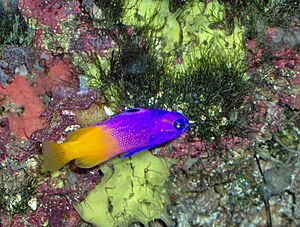Fairy basslet facts for kids
Quick facts for kids Fairy basslet |
|
|---|---|
 |
|
| Conservation status | |
| Scientific classification |
The royal gramma (Gramma loreto), also known as the fairy basslet, is a beautiful species of fish. It lives in the warm, tropical waters of the western Atlantic Ocean. You can find these fish around reefs, which are like underwater cities made of coral. Many people also keep royal grammas in their home aquariums.
Contents
What Does the Royal Gramma Look Like?
This fish has a stunning color pattern. Its head is a light purple or deep violet. This color slowly changes to a golden yellow as you move towards its tail.
The royal gramma also has a small black spot on the front of its top fin, called the dorsal fin. A black line goes through its eye.
It looks a bit like another fish called the false gramma (Pictichromis paccagnellae). But there are two main ways to tell them apart. The false gramma has clear fins. Also, its colors change sharply, instead of fading smoothly like the royal gramma.
Royal grammas are quite small. They usually grow to be a little over 8 centimeters (about 3 inches) long. Some have even been bred in tanks. The biggest one ever measured by scientists was 8 centimeters long.
What Do Royal Grammas Eat?
The royal gramma is a planktivore. This means it mostly eats tiny floating creatures called zooplankton. It also enjoys eating small crustaceans, like tiny shrimp.
Interestingly, the royal gramma is also a cleaner fish. It helps other fish by removing ectoparasites from their skin. Ectoparasites are tiny creatures that live on the outside of a fish and can harm them. Royal grammas also learn to eat dead food, such as pieces of crustaceans and fish. They like to pick their food from the middle of the water.
Where Do Royal Grammas Live?
You can find royal grammas in many places in the western Atlantic. Their natural home includes the waters around the Bahamas, Venezuela, the Antilles, and Bermuda. They also live near Central America and the northern part of South America.
Royal grammas usually swim closer to the bottom of the ocean. They can be found at depths between 1 and 20 meters (about 3 to 60 feet).
Royal Grammas in Aquariums
Royal grammas are often a great choice for home aquariums. They are usually peaceful, small, and have simple diets. This makes them good tank mates for coral and other invertebrates.
However, if they are kept in very small tanks, like nano reef tanks, they can sometimes become aggressive towards other fish. They like to claim territories among rocks and in small hiding spots. They will protect these spots and might chase away other small fish.
When startled, they will quickly dart back into their hiding places. If they feel threatened, they will open their mouths wide to warn off intruders. Royal grammas sometimes swim in unusual ways, like straight up and down or even upside down under ledges. This is normal behavior and doesn't mean they are sick! They are just orienting themselves to the closest surface.
Setting Up Their Tank
A tank for a royal gramma should be at least 30 gallons. The lighting in the tank should not be too bright. The water temperature should be between 72 and 78 degrees Fahrenheit (22-26°C). The water's pH level should be between 8.1 and 8.4. The specific gravity (which measures how salty the water is) should be between 1.020 and 1.025.
They are often kept in reef aquariums. Usually, people keep them alone or in a pair. You can keep small groups if the tank is big enough. Each fish needs its own cracks and crevices to hide in. It's best not to keep royal grammas with other royal grammas unless they are a male-female pair. Also, avoid keeping them with larger, aggressive fish that might try to eat them.
Royal grammas are quite resistant to most diseases. This makes them a good choice for beginners. They will eat frozen and meaty foods. In the wild, they eat things like brine shrimp and mysis shrimp. Royal grammas are easy to feed. Giving them different kinds of food can stop them from becoming picky eaters. In captivity, they will also eat flake and pellet foods.
Reproduction
It can be hard to tell the difference between male and female royal grammas. Males are usually larger than females. Even so, they are quite easy to breed in an aquarium.
The male fish will build a nest among the rocks using pieces of algae. He then leads the female to this nest. The female will lay between 20 and 100 eggs in the nest.
The male takes care of the nest and eggs. He protects them, keeps the nest clean, and often bumps into the nest. This behavior can happen almost every day for a month or even longer during the breeding season.
The eggs are very tiny, about 1 millimeter (0.04 inches) across. They have small bumps with tiny threads on them. These threads help the eggs stick to the algae in the nest. The eggs will hatch in about five to seven days, usually in the evening. Once they hatch, the baby fish can eat tiny organisms called rotifers. When they grow a bit bigger, they can eat newly hatched brine shrimp.




